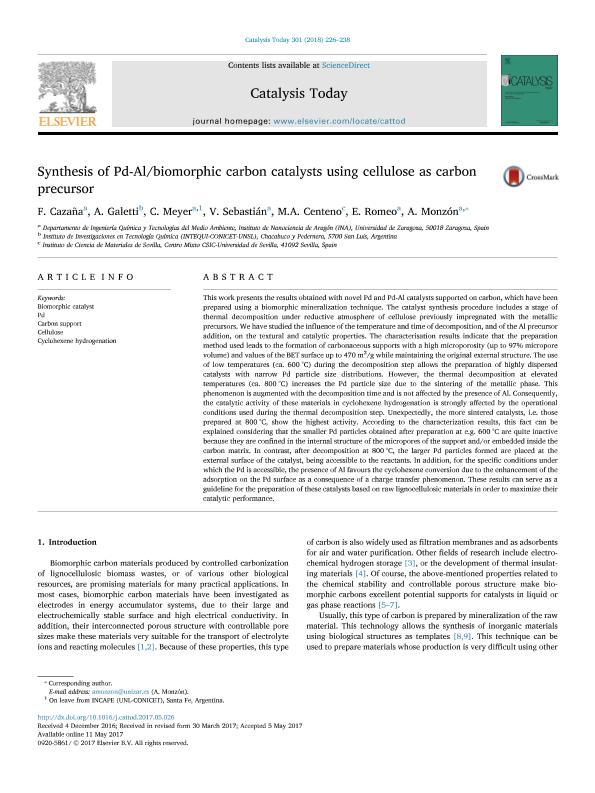Mostrar el registro sencillo del ítem
dc.contributor.author
Cazaña, F.
dc.contributor.author
Galetti, Agustin Esteban

dc.contributor.author
Meyer, Camilo Ignacio

dc.contributor.author
Sebastián, V.
dc.contributor.author
Centeno, M.A.
dc.contributor.author
Romeo, E.
dc.contributor.author
Monzón, A.
dc.date.available
2019-11-07T19:36:11Z
dc.date.issued
2018-03
dc.identifier.citation
Cazaña, F.; Galetti, Agustin Esteban; Meyer, Camilo Ignacio; Sebastián, V.; Centeno, M.A.; et al.; Synthesis of Pd-Al/biomorphic carbon catalysts using cellulose as carbon precursor; Elsevier Science; Catalysis Today; 301; 3-2018; 226-238
dc.identifier.issn
0920-5861
dc.identifier.uri
http://hdl.handle.net/11336/88233
dc.description.abstract
This work presents the results obtained with novel Pd and Pd-Al catalysts supported on carbon, which have been prepared using a biomorphic mineralization technique. The catalyst synthesis procedure includes a stage of thermal decomposition under reductive atmosphere of cellulose previously impregnated with the metallic precursors. We have studied the influence of the temperature and time of decomposition, and of the Al precursor addition, on the textural and catalytic properties. The characterisation results indicate that the preparation method used leads to the formation of carbonaceous supports with a high microporosity (up to 97% micropore volume) and values of the BET surface up to 470 m2/g while maintaining the original external structure. The use of low temperatures (ca. 600 °C) during the decomposition step allows the preparation of highly dispersed catalysts with narrow Pd particle size distributions. However, the thermal decomposition at elevated temperatures (ca. 800 °C) increases the Pd particle size due to the sintering of the metallic phase. This phenomenon is augmented with the decomposition time and is not affected by the presence of Al. Consequently, the catalytic activity of these materials in cyclohexene hydrogenation is strongly affected by the operational conditions used during the thermal decomposition step. Unexpectedly, the more sintered catalysts, i.e. those prepared at 800 °C, show the highest activity. According to the characterization results, this fact can be explained considering that the smaller Pd particles obtained after preparation at e.g. 600 °C are quite inactive because they are confined in the internal structure of the micropores of the support and/or embedded inside the carbon matrix. In contrast, after decomposition at 800 °C, the larger Pd particles formed are placed at the external surface of the catalyst, being accessible to the reactants. In addition, for the specific conditions under which the Pd is accessible, the presence of Al favours the cyclohexene conversion due to the enhancement of the adsorption on the Pd surface as a consequence of a charge transfer phenomenon. These results can serve as a guideline for the preparation of these catalysts based on raw lignocellulosic materials in order to maximize their catalytic performance.
dc.format
application/pdf
dc.language.iso
eng
dc.publisher
Elsevier Science

dc.rights
info:eu-repo/semantics/openAccess
dc.rights.uri
https://creativecommons.org/licenses/by-nc-sa/2.5/ar/
dc.subject
BIOMORPHIC CATALYST
dc.subject
CARBON SUPPORT
dc.subject
CELLULOSE
dc.subject
CYCLOHEXENE HYDROGENATION
dc.subject
PD
dc.subject.classification
Ingeniería de Procesos Químicos

dc.subject.classification
Ingeniería Química

dc.subject.classification
INGENIERÍAS Y TECNOLOGÍAS

dc.title
Synthesis of Pd-Al/biomorphic carbon catalysts using cellulose as carbon precursor
dc.type
info:eu-repo/semantics/article
dc.type
info:ar-repo/semantics/artículo
dc.type
info:eu-repo/semantics/publishedVersion
dc.date.updated
2019-10-23T21:00:36Z
dc.journal.volume
301
dc.journal.pagination
226-238
dc.journal.pais
Países Bajos

dc.journal.ciudad
Amsterdam
dc.description.fil
Fil: Cazaña, F.. Universidad de Zaragoza; España
dc.description.fil
Fil: Galetti, Agustin Esteban. Consejo Nacional de Investigaciones Científicas y Técnicas. Centro Científico Tecnológico Conicet - San Luis. Instituto de Investigaciones en Tecnología Química. Universidad Nacional de San Luis. Facultad de Química, Bioquímica y Farmacia. Instituto de Investigaciones en Tecnología Química; Argentina
dc.description.fil
Fil: Meyer, Camilo Ignacio. Universidad de Zaragoza; España
dc.description.fil
Fil: Sebastián, V.. Universidad de Zaragoza; España
dc.description.fil
Fil: Centeno, M.A.. Universidad de Sevilla; España
dc.description.fil
Fil: Romeo, E.. Universidad de Zaragoza; España
dc.description.fil
Fil: Monzón, A.. Universidad de Zaragoza; España
dc.journal.title
Catalysis Today

dc.relation.alternativeid
info:eu-repo/semantics/altIdentifier/url/https://www.sciencedirect.com/science/article/pii/S0920586117303358?via%3Dihub
dc.relation.alternativeid
info:eu-repo/semantics/altIdentifier/doi/http://dx.doi.org/10.1016/j.cattod.2017.05.026
Archivos asociados
